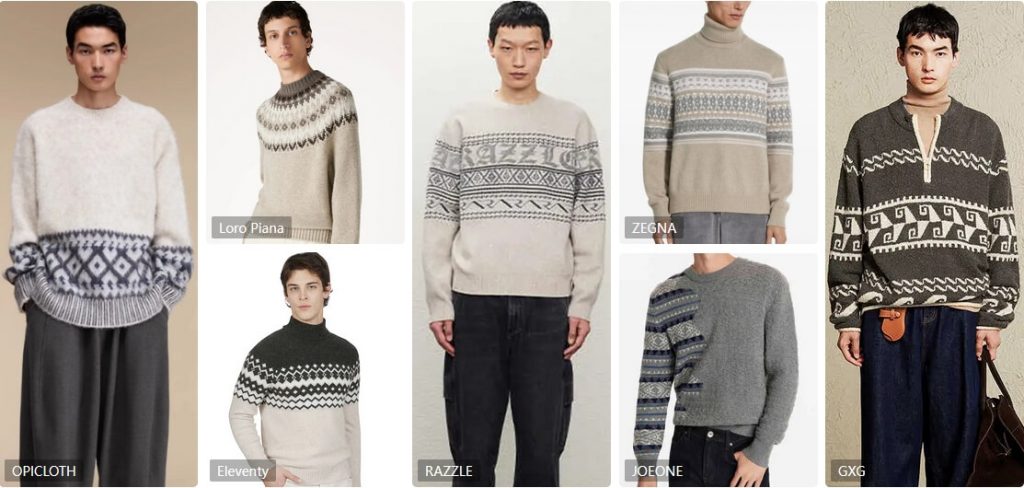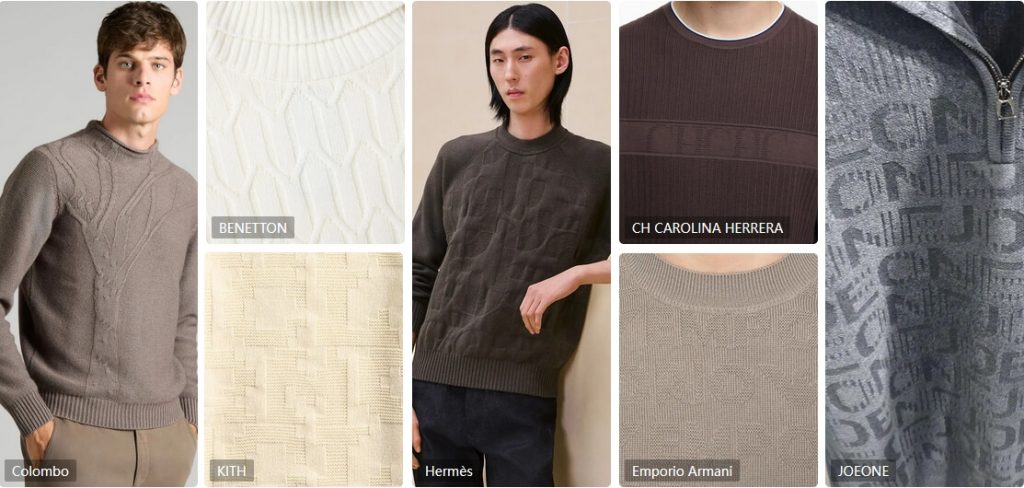As we move into the 2024-2025 fall/winter season, the trends in men’s sweaters continue to evolve, blending innovative designs with technical craftsmanship. Based on the analysis of POP‘s November user download data for the TOP 100 men’s sweaters, several key trends have emerged. Minimalist commuter-style sweaters have gained significant traction, followed closely by fashionable casual designs. Additionally, intricate patterns, advanced knitting techniques, and carefully considered pocket designs have all played pivotal roles in shaping the market. Here’s a deeper look into the key trends, focusing on yarn types, knitting techniques, and design elements that define the future of men’s sweaters.
Table of Contents
ToggleTop 10 Men’s Sweaters

Luxury brands like Louis Vuitton and ZEGNA remain the dominant forces in the men’s sweater market, with their ability to combine both business and casual elements. These brands leverage high-quality yarns such as merino wool, cashmere, and silk blends to create soft, breathable sweaters that exude luxury. Merino wool is known for its fine, lightweight, and moisture-wicking properties, making it ideal for year-round wear. Cashmere, on the other hand, is favored for its plush, silky texture, which provides unparalleled comfort.
Knitting techniques like intarsia and jacquard are often employed in these high-end sweaters to create intricate patterns, showcasing the craftsmanship and attention to detail. These methods are ideal for producing sharp, clean designs that hold their shape and texture over time.
Minimalist Commuter Style

The minimalist commuter style is a growing trend among modern professionals who favor simplicity and versatility in their wardrobe. This style primarily focuses on sleek, well-tailored sweaters that use minimalistic designs to create a refined yet relaxed look. Key features of these sweaters include clean lines, neutral tones (such as charcoal grey, navy, and ivory), and high-quality yarns such as superfine merino or cashmere blends.
In terms of knitting, fine-gauge knitting techniques are widely used in minimalist designs. Fine-gauge knitting involves using thinner yarns to create a smooth, lightweight fabric that is soft to the touch and offers a sleek, refined look. These sweaters are perfect for layering, making them ideal for both business and casual environments. Subtle design elements like contrast stitching, ribbed cuffs, and color-blocked collars add a contemporary twist without overwhelming the overall design.
Fashionable Casual Style

Fashionable casual sweaters are defined by their relaxed fit and bold, eye-catching designs. These sweaters cater to individuals who seek comfort but don’t want to compromise on style. Popular yarns for casual sweaters include cotton, alpaca, and cashmere blends. Cotton is known for its breathability and softness, making it perfect for warmer climates, while alpaca yarn adds a unique softness and insulating quality that is ideal for colder seasons.
Knitting techniques like textured stitches, such as seed stitch or basket weave, are often employed to add depth and visual interest to these sweaters. Seed stitch, which alternates between knit and purl stitches, creates a subtle, bumpy texture, while basket weave incorporates large, interwoven panels that create a bold, three-dimensional effect. These techniques make the sweaters stand out without being too loud. Additionally, bold color choices, oversized fits, and playful patterns, such as stripes and geometric prints, define this category.
Zip-up Sweaters

Zip-up sweaters have seen a significant rise in popularity due to their versatility and practicality. Typically crafted from heavier yarns such as wool, merino wool blends, or even recycled fibers, these sweaters are ideal for layering. The zip-up design adds functionality, making these sweaters easy to wear and adjust based on the weather or activity level.
In terms of knitting techniques, zip-up sweaters often feature ribbed knitting at the cuffs, hem, and collar to ensure a snug fit that retains warmth. Additionally, double-knit or interlock knitting is used to create a thicker, sturdier fabric that enhances both durability and insulation. The incorporation of high-quality zippers—often made from brass or custom designs—adds an extra layer of luxury to these otherwise utilitarian garments.
Crew Neck Sweaters

Crew neck sweaters are a timeless piece that never goes out of style. Their simple yet versatile design makes them suitable for a wide range of occasions. These sweaters are typically made from fine merino wool, cotton, or high-quality blends like cashmere and silk. The soft texture of merino wool allows the fabric to maintain its shape and warmth without feeling heavy, while the luxurious softness of cashmere elevates the overall feel of the garment.
From a technical perspective, ribbed knitting is often employed around the neckline, cuffs, and hem to give the sweater structure and allow for a comfortable fit. For added texture, cable knitting and twist stitches are used, providing a visually appealing, tactile element to the sweater. Cable knitting, which involves crossing the yarn in intricate patterns, adds dimension to otherwise plain sweaters. Twist stitches, meanwhile, can create a spiral effect that enhances the overall appearance of the fabric.
Polo Neck Sweaters

Polo neck sweaters, also known as turtlenecks, are gaining popularity for their sophisticated yet casual look. They are particularly favored for their versatility in both business and casual settings. These sweaters are typically crafted from high-quality wool or cashmere to provide warmth and comfort.
In terms of knitting, double-knit techniques are often employed for polo neck sweaters to ensure the fabric is both soft and sturdy. The double-knit technique creates a thick, plush fabric that provides insulation without being too bulky. The high collar is often knitted using ribbed or garter stitch techniques, providing a flexible and comfortable fit. These sweaters can also feature additional design elements, such as Jacquard patterns or Fair Isle knitting, adding intricate patterns and visual interest to the overall design.
Geometric Stripes

Geometric stripes have emerged as a bold, graphic trend for the 2024-2025 fall/winter season, offering a modern twist on traditional stripe patterns. These sweaters use contrasting yarn colors to create eye-catching patterns, often involving sharp, angular lines or asymmetrical designs. Geometric stripes can be combined with other patterns, such as chevron or zig-zag, to create a dynamic visual effect.
In terms of knitting techniques, fair isle or intarsia knitting is often used to create seamless color transitions and block patterns. Intarsia, in particular, is used for large blocks of color, while Fair Isle is ideal for smaller patterns or motifs. These techniques allow designers to create highly detailed geometric designs that remain sharp and precise.
Typography Designs

Typography-based sweaters, featuring bold graphic text or slogans, are gaining popularity in both casual and streetwear styles. These sweaters typically feature words or phrases woven into the fabric through jacquard or intarsia knitting. The yarns used for these designs often include a mix of synthetic fibers like acrylic or nylon, which help achieve vivid, long-lasting colors.
The text is often rendered in bold, capitalized letters, providing a clear visual message. To enhance these designs, techniques like embroidered lettering or appliqué are also used, adding texture and depth to the text-based elements. Typography designs are perfect for customers who want to make a statement through their clothing, while still maintaining a sense of style.
Delicate Textures

Textures play an increasingly important role in men’s sweaters, adding visual interest and tactile appeal. Delicate textures, created using techniques like seed stitch, basket weave, and waffle weave, offer a sophisticated and refined look without being too bold. These textures create depth and movement within the fabric, making even the simplest designs stand out.
Advanced knitting techniques, such as lace knitting or honeycomb stitch, are used to create open, airy patterns that are ideal for layering during the transitional seasons. These delicate textures add a layer of complexity and elegance to sweaters, allowing them to move seamlessly between casual and semi-formal settings.
Pocket Designs

Innovative pocket designs have become a hallmark of modern men’s sweaters. These pockets are not just functional; they are key design features that can add a unique touch to an otherwise simple sweater. Pockets can be placed asymmetrically, feature zippers, or be oversized, depending on the desired look.
From a technical standpoint, these pockets are often crafted using ribbing or reverse stockinette stitches to provide texture and structure. The use of contrasting yarns for the pocket linings can also add a subtle design detail that enhances the overall aesthetic. Additionally, pockets can be seamlessly incorporated into the overall design using intarsia or jacquard techniques, allowing them to blend into the pattern without disrupting the sweater’s visual flow.
Conclusion
In conclusion, the men’s sweater trends for the 2024-2025 fall/winter season showcase a perfect blend of technical craftsmanship, innovative designs, and modern styles. From the minimalist commuter style to bold geometric patterns and intricate knitting techniques, these sweaters cater to a wide range of preferences and needs. For those looking to stay ahead of the curve with stylish, high-quality sweaters that offer both luxury and functionality, these trends highlight the importance of selecting the right yarns and knitting techniques.
By incorporating these trends into your offerings, you can provide customers with sweaters that not only look good but feel exceptional.
If you’re looking to stay ahead of the curve with stylish, versatile sweaters that blend business and casual elements, HD is the perfect partner. We offer small-batch wholesale, OEM, and ODM services to create custom pieces that suit your brand’s unique needs. Contact us today to start creating your next collection.




